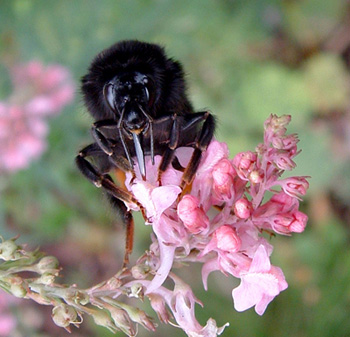Wildlife gardening - Bumblebees
Making the garden friendly to bumblebees

Bumblebees are larger and rounder than other bees and are noticeably furry in comparison. They also move a lot more slowly than smaller bees and are less aggressive; in fact they will only sting if you do something like sit on them or try to pick them up. Male bumblebees, called drones, don’t even have a sting. Because bumble bees pollinate flowers, this helps you have a beautiful garden, so don't be afraid of bees, they are another gardener's friend and every wildlife garden should have the buzz of bumblebees in summer.
Because they don’t sting readily, you can get close up to see them in more detail. Wait for a bumblebee to settle on a flower and then watch as it moves about – you might see it stick its ‘tongue’ out to get the nectar, like in the picture on the right.
Bumblebees don’t live in hives but in small nests, so there isn’t the same concern about them swarming as there is with, say, honey bees. This means that you can encourage them to nest in your garden without worrying that you’ll get a swarm of them.
Flowers for bumblebees
The best flowers for bees of any kind are simple and open, as these carry more of the nectar and pollen that bees need, compared to double-flowered types. A garden stocked with a wide variety of flowering plants – like a typical English cottage garden – is ideal bee territory but, if you see many bees on a particular plant, then grow more of it. In my garden the bees are very fond of linaria and oregano.

Bee on Linaria

Bee in a foxglove flower
What to grow
A good list to start with is foxgloves, hollyhocks, heather, lavender, oregano, cornflowers, honeysuckle, mint, cotoneaster, linaria borage, clover, marigolds, and beans.
It’s also a good idea to make sure that you have something in flower all year round so that bees which wake up during spells of warm weather can find a food source. Even in mid-winter, when there is snow on the ground, it is possible to have flowers. Try winter flowering heather, Christmas roses, primroses, snowdrops and winter aconite.
The main job of bumblebees is to pollinate flowers and a huge amount of all our food is the result of pollination by bees. Beans rely on bees to pollinate the flowers and without the bees, there will be no crops to harvest. We need to safeguard their future - not just for them, but for us as well.
Nesting sites for bumblebees
As well as helping bees by planting food for them, you can provide nesting places. Bumblebees use a variety of nesting places – holes in dry banks, walls, under sheds, under large stones and in the leaf litter at the base of hedges. Leave some places in the garden undisturbed so that they can find somewhere to build a nest.
Hibernation
The queen is the only one to hibernate and she will find a hole or a sheltered pile of moss or leaves to crawl into for the winter. If you find a sleepy bee in the cold days of late winter or early spring, don’t disturb her, but carefully cover her back up again so she can finish her winter sleep till the weather warms up.
Helping out
You can help bees by not being too tidy in your garden. Leave them somewhere to nest - you can fill old plant pots with moss and put them on their sides under shrubs; the bees will find them and hibernate in the dry moss.
Allow clover to grow in the lawn so they can feed from the nectar of the flowers. If you don't have a pond, put out large shallow dishes of water with stones in them so that the bees can get a drink - large plant saucers are good for this. They will stand on the stones to get to the water and will also be able to climb out if they fall in.
If you help the bees, they will help you by pollinating your plants so that you have plenty of fruit and vegetables to eat.

Bee on Helenium flower

© Copyright Miranda Hodgson 2007